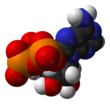Adenosine Triphosphate
Adenosine triphosphate (ATP) is an organic compound that serves as a source of stored energy in all living cells. ATP works by transferring a phosphate group to one of its partner molecules, releasing energy. This energy is used to power a wide range of cellular processes, such as muscle contraction, active transport, and the synthesis of nucleic acids and proteins. ATP helps to regulate the metabolic pathways of cells and is essential for life.
Adenosine triphosphate (ATP) is an organic compound that provides energy to drive many processes in living cells, such as muscle contraction, nerve impulse propagation, condensate dissolution, and chemical synthesis. Found in all known forms of life, ATP is often referred to as the "molecular unit of currency" of intracellular energy transfer. When consumed in metabolic processes, it converts either to adenosine diphosphate (ADP) or to adenosine monophosphate (AMP). Other processes regenerate ATP. The human body recycles its own body weight equivalent in ATP each day. It is also a precursor to DNA and RNA, and is used as a coenzyme.

| |||
|
| |||
| Names | |||
|---|---|---|---|
| IUPAC name
Adenosine 5′-(tetrahydrogen triphosphate)
| |||
| Preferred IUPAC name
O1-{[(2R,3S,4R,5R)-5-(6-Amino-9H-purin-9-yl)-3,4-dihydroxyoxolan-2-yl]methyl} tetrahydrogen triphosphate | |||
| Identifiers | |||
| |||
3D model (JSmol)
|
|||
| ChEBI | |||
| ChEMBL | |||
| ChemSpider | |||
| DrugBank | |||
| ECHA InfoCard | 100.000.258 | ||
| KEGG | |||
PubChem CID
|
|||
| UNII | |||
CompTox Dashboard (EPA)
|
|||
| |||
| |||
| Properties | |||
| C10H16N5O13P3 | |||
| Molar mass | 507.18 g/mol | ||
| Density | 1.04 g/cm3 (disodium salt) | ||
| Melting point | 187 °C (369 °F; 460 K) disodium salt; decomposes | ||
| Acidity (pKa) | 0.9, 1.4, 3.8, 6.5 | ||
| UV-vis (λmax) | 259 nm | ||
| Absorbance | ε259 = 15.4 mM−1 cm−1 | ||
Except where otherwise noted, data are given for materials in their standard state (at 25 °C [77 °F], 100 kPa).
| |||
From the perspective of biochemistry, ATP is classified as a nucleoside triphosphate, which indicates that it consists of three components: a nitrogenous base (adenine), the sugar ribose, and the triphosphate.












